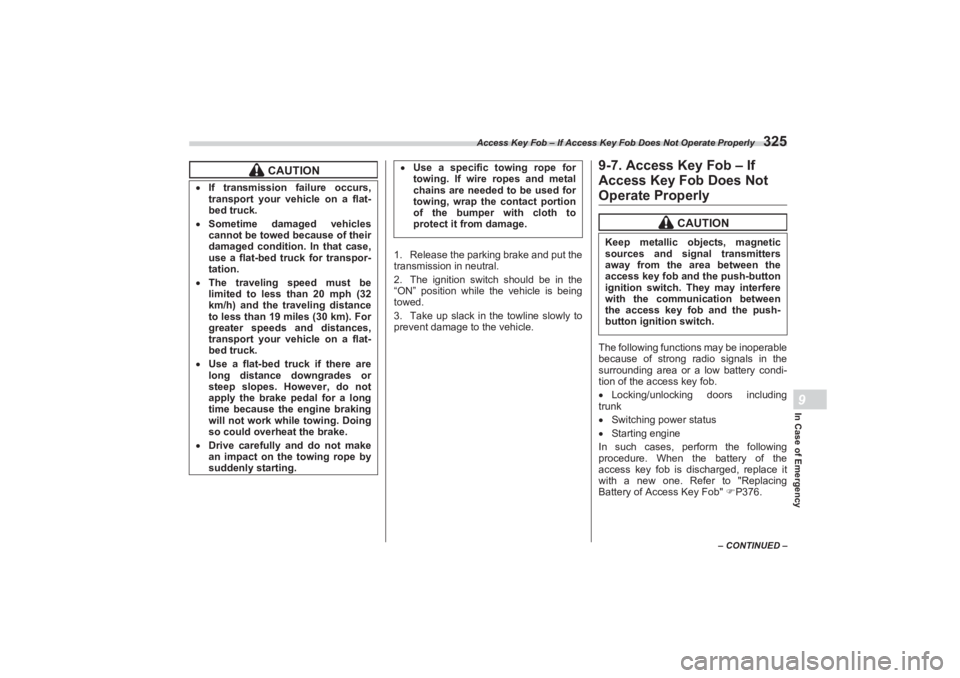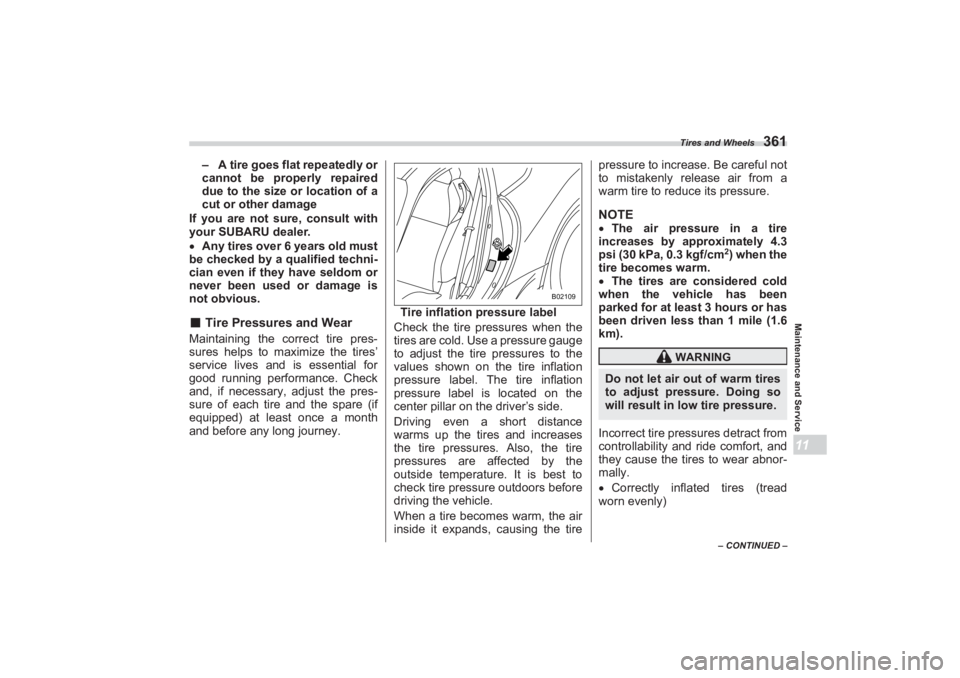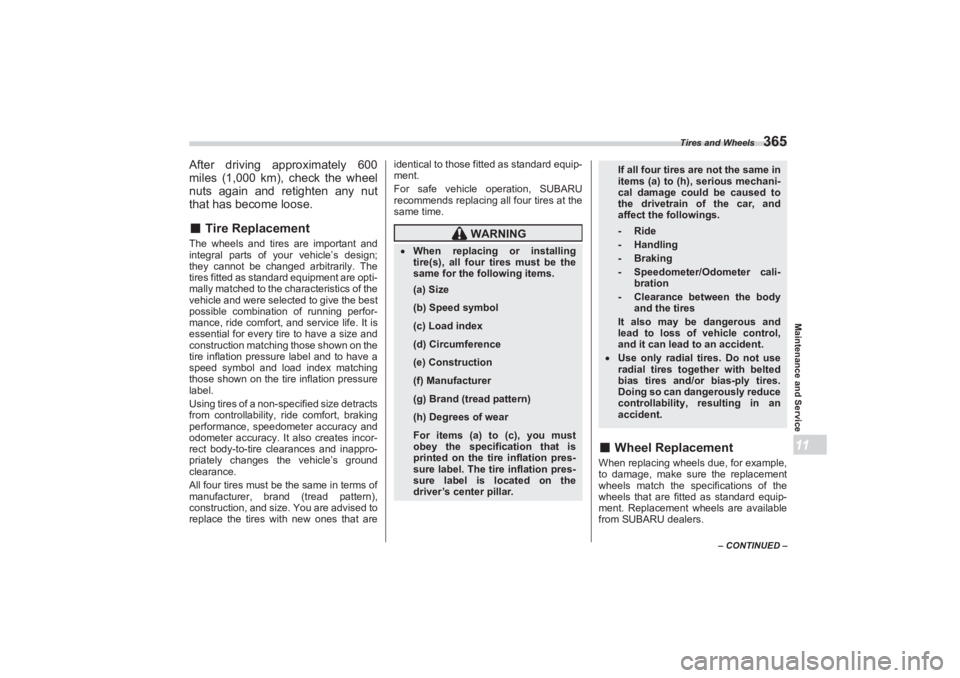2023 SUBARU BRZ run flat
[x] Cancel search: run flatPage 321 of 432

Flat Tires
315
In Case of Emergency9
– CONTINUED –
■Tire Pressure Monitoring
System (TPMS) (If Equipped)Low tire pressure warning lightThe tire pressure monitoring system
provides the driver with the warning
message indicated by sending a signal
from a sensor that is installed in each
wheel when tire pressure is severely low.
The tire pressure mo nitoring system will
activate only when the vehicle is driven.
Also, this system may not react immedi-
ately to a sudden drop in tire pressure (for
example, a blow-out caused by running
over a sharp object).
702780
WARNING
If the low tire pressure warning
light illuminates while driving,
never brake suddenly. Instead,
perform the following procedure.
Otherwise an accident involving
serious vehicle damage and
serious personal injury could
occur.
(1) Keep driving straight ahead
while gradually reducing
speed.(2) Slowly pull off the road to a
safe place.(3) Check the pressure for all
four tires and adjust the pres-
sure to the CO LD tire pres-
sure shown on the vehicle
placard on the center pillar on
the driver’s side.If this light still illuminates while
driving after adjusting the tire
pressure, a tire may have signifi-
cant damage and a fast leak that
causes the tire to lose air rapidly.
If you have a flat tire, replace it
with a spare tire as soon as pos-
sible.
When a spare tire is mounted or a
wheel rim is replaced without the
original pressure sensor/trans-
mitter being transferred, the low
tire pressure warning light will
illuminate steadily after blinking
for approximately one minute.
This indicates the TPMS is unable
to monitor all four road wheels.
Contact your SUBARU dealer as
soon as possible for tire and
sensor replacement and/or
system resetting. When a tire is repaired with liquid
sealant, the tire pressure warning
valve and transmitter may not
operate properly. If a liquid
sealant is used, contact your
nearest SUBARU dealer or other
qualified service shop as soon as
possible. Make sure to replace
the tire pressure warning valve
and transmitter when replacing
the tire. You may reuse the wheel
if there is no damage to it and if
the sealant residue is properly
cleaned off.
If the light illuminates steadily
after blinking for approximately
one minute, promptly contact a
SUBARU dealer to have the sys-
tem inspected.
BRZ_U.book 315 ページ 2022年3月29日 火曜日 午後3時59分
Page 330 of 432

Towing
324holes, return the plugs to their original
places.■Using a Flat-Bed Truck
This is the best way to transport your
vehicle. Use the following procedures to
ensure safe transportation.
1. Shift the select lever into the “P” posi-
tion for AT models. Sh ift the shift lever into
the 1st position for MT models.
2. Apply the parking brake firmly.
3. Secure the vehicle onto the carrier
properly with safety chains. Each safety
chain should be equally tightened and
care must be taken not to pull the chains
so tightly that the suspension bottoms out.
■ Towing with All Wheels on
the Ground
WARNING
Use the rear tie-down holes only for
downward anchoring. If they are
used to anchor the vehicle in any
other direction, cables may slip out
of the holes, possibly causing a
dangerous situation.
900488
CAUTION
Transport by flat -bed truck may
cause the headlights to become
misaligned. In such a case, have the
headlight alignment checked by a
SUBARU dealer after transporting
the vehicle by flat-bed truck.
WARNING
Never turn the ignition switch to
the “OFF” position while the
vehicle is being towed because
the steering wheel and the direc-
tion of the wheels will be locked. Remember that the brake booster
and power steering do not func-
tion when the engine is not
running. Because the engine is
turned off, it w ill take greater
effort to operate the brake pedal
and steering wheel.
900489
BRZ_U.book 324 ページ 2022年3月29日 火曜日 午後3時59分
Page 331 of 432

Access Key Fob – If Access Key Fob Does Not Operate Properly
325
In Case of Emergency9
– CONTINUED –
1. Release the parking brake and put the
transmission in neutral.
2. The ignition switch should be in the
“ON” position while the vehicle is being
towed.
3. Take up slack in the towline slowly to
prevent damage to the vehicle.
9-7. Access Key Fob – If
Access Key Fob Does Not Operate ProperlyThe following functions may be inoperable
because of strong radio signals in the
surrounding area or a low battery condi-
tion of the access key fob.
Locking/unlocking doors including
trunk
Switching power status
Starting engine
In such cases, perform the following
procedure. When t he battery of the
access key fob is discharged, replace it
with a new one. Refer to "Replacing
Battery of Access Key Fob" P376.
CAUTION
If transmission failure occurs,
transport your vehicle on a flat-
bed truck. Sometime damaged vehicles
cannot be towed because of their
damaged condition. In that case,
use a flat-bed truck for transpor-
tation. The traveling speed must be
limited to less than 20 mph (32
km/h) and the traveling distance
to less than 19 miles (30 km). For
greater speeds and distances,
transport your vehicle on a flat-
bed truck. Use a flat-bed truck if there are
long distance downgrades or
steep slopes. However, do not
apply the brake pedal for a long
time because the engine braking
will not work while towing. Doing
so could overheat the brake. Drive carefully and do not make
an impact on the towing rope by
suddenly starting.
Use a specific towing rope for
towing. If wire ropes and metal
chains are needed to be used for
towing, wrap the contact portion
of the bumper with cloth to
protect it from damage.
CAUTION
Keep metallic objects, magnetic
sources and signal transmitters
away from the area between the
access key fob and the push-button
ignition switch. They may interfere
with the communication between
the access key fob and the push-
button ignition switch.
BRZ_U.book 325 ページ 2022年3月29日 火曜日 午後3時59分
Page 347 of 432

Maintenance Tips
341
Maintenance and Service11
– CONTINUED –
■When Checking or Servicing
in the Engine Compartment
While the Engine Is Running
11-3. Maintenance TipsSome clips and fender linings must be
removed before replacing the air cleaner
element or specific bulbs.■ Removing and Reinstalling
Clips▼ Removing clips
There are several types of clips used for
your vehicle.
▽Type A and D clipsType A clips Type D clips
1. Turn the clips co
unterclockwise using
a flat-head screwdriver until the center
portion of the clip is raised.
2. Remove the clips with a flat-head
screwdriver using leverage.
CAUTION
Do not contact the belt cover
while checking the components
in the engine compartment.
Doing so may cause your hand to
slip off the belt cover and result in
an unexpected injury. Do not touch the o il filter until the
engine has cooled down
completely. Doing so may result
in a burn or other injury. Note that
the oil filter becomes very hot
when the engine is running and
remains hot for so me time after
the engine has stopped.
WARNING
A running engine can be danger-
ous. Keep your fingers, hands,
clothing, hair and tools away from
the cooling fan, belts and any other
moving engine parts. Removing
rings, watches and ties is advisable.
B01036
B01536
BRZ_U.book 341 ページ 2022年3月29日 火曜日 午後3時59分
Page 364 of 432

Tires and Wheels
35811-21. Tires and Wheels■Types of TiresYou should be familiar with type of tires
present on your vehicle.
▼ Summer tires
The factory-installed tires on your new
vehicle are summer tires.
Summer tires are high-speed capability
tires best suited for highway driving under
dry conditions.
Summer tires are inadequate for driving
on slippery roads such as on snow-
covered or icy roads.
If you drive your vehicle on snow-covered
or icy roads, we strongly recommend the
use of winter (snow) tires.
When installing winter tires, be sure to
replace all four tires.
▼ All season tires
All season tires are designed to provide
an adequate measure of traction, handling
and braking performance in year-round
driving including snowy and icy road
conditions. However all season tires do
not offer as much traction performance as
winter (snow) tires in heavy or loose snow
or on icy roads. All season tires are identified by “ALL
SEASON” and/or “M+S” (Mud & Snow) on
the tire sidewall.
▼ Winter (snow) tires
Winter tires are best suited for driving on
snow-covered and icy roads. However
winter tires do not perform as well as
summer tires and all season tires on roads
other than snow-covered and icy roads.
NOTEIf the tread wears down below 0.16 in.
(4mm) on snow tires the effectiveness
of snow tires is lost.
▼ Low profile tires
Generally, low profile tires will wear more
rapidly and tire grip performance will be
reduced on snowy and/or icy roads when
compared to standard tires. Be sure to
use snow tires or tire chains on snowy
and/or icy roads and drive carefully at a
speed appropriate for road and weather
conditions.NOTELow profile tires may cause greater
damage than usual to the wheel when
receiving impact from the road sur-
face. Therefore pay attention to the fol-
lowing:
Be sure to use proper tire inflation
pressure. If tires are under-inflated,
they may be damaged more severely.
Avoid pot holes, uneven pavement,
curbs and other road hazards. Failure
to do so may lead to severe tire and
wheel damage.
■ Tire Pressure Monitoring
System (TPMS) (If Equipped)The tire pressure monitoring system
provides the driver with a warning
message by sending a signal from a
sensor that is installed in each wheel
when tire pressure is severely low. The
tire pressure monitoring system will acti-
vate only when the vehicle is driven. Also,
this system may not react immediately to
a sudden drop in tire pressure (for
example, a blow-out caused by running
over a sharp object).
If you adjust the tire pressures in a warm
garage and will then drive the vehicle in
cold outside air, the resulting drop in tire
pressures may cause the low tire pressure
warning light to illuminate. To avoid this
problem when adjusting the tire pressures
in a warm garage, inflate the tires to pres-
sures higher than those shown on the tire
inflation pressure label. Specifically,
inflate them by an extra 1 psi (6.9 kPa,
0.07 kgf/cm
2) for every difference of 10°F
BRZ_U.book 358 ページ 2022年3月29日 火曜日 午後3時59分
Page 367 of 432

Tires and Wheels
361
Maintenance and Service11
– CONTINUED –
– A tire goes flat repeatedly or
cannot be properly repaired
due to the size or location of a
cut or other damage
If you are not su re, consult with
your SUBARU dealer.
Any tires over 6 years old must
be checked by a qualified techni-
cian even if they have seldom or
never been used or damage is
not obvious.
■ Tire Pressures and WearMaintaining the correct tire pres-
sures helps to maximize the tires’
service lives and is essential for
good running performance. Check
and, if necessary, adjust the pres-
sure of each tire and the spare (if
equipped) at least once a month
and before any long journey. Tire inflation pressure label
Check the tire pressures when the
tires are cold. Use a pressure gauge
to adjust the tire pressures to the
values shown on the tire inflation
pressure label. The tire inflation
pressure label is located on the
center pillar on the driver’s side.
Driving even a short distance
warms up the tires and increases
the tire pressures. Also, the tire
pressures are affected by the
outside temperature. It is best to
check tire pressure outdoors before
driving the vehicle.
When a tire becomes warm, the air
inside it expands, causing the tire pressure to increase. Be careful not
to mistakenly release air from a
warm tire to reduce its pressure.
NOTE The air pressure in a tire
increases by approximately 4.3
psi (30 kPa, 0.3 kgf/cm
2) when the
tire becomes warm.
The tires are considered cold
when the vehicle has been
parked for at least 3 hours or has
been driven less than 1 mile (1.6
km).
Incorrect tire pressures detract from
controllability and ride comfort, and
they cause the tires to wear abnor-
mally.
Correctly inflated tires (tread
worn evenly)
B02109
WARNING
Do not let air out of warm tires
to adjust pressure. Doing so
will result in low tire pressure.
BRZ_U.book 361 ページ 2022年3月29日 火曜日 午後3時59分
Page 371 of 432

Tires and Wheels
365
Maintenance and Service11
– CONTINUED –
After driving approximately 600
miles (1,000 km), check the wheel
nuts again and retighten any nut
that has become loose.■ Tire ReplacementThe wheels and tires are important and
integral parts of your vehicle’s design;
they cannot be changed arbitrarily. The
tires fitted as standard equipment are opti-
mally matched to the characteristics of the
vehicle and were sele cted to give the best
possible combination of running perfor-
mance, ride comfort, and service life. It is
essential for every tire to have a size and
construction matching those shown on the
tire inflation pressure label and to have a
speed symbol and load index matching
those shown on the tire inflation pressure
label.
Using tires of a non-specified size detracts
from controllability, ride comfort, braking
performance, speedometer accuracy and
odometer accuracy. It also creates incor-
rect body-to-tire clearances and inappro-
priately changes the vehicle’s ground
clearance.
All four tires must be the same in terms of
manufacturer, brand (tread pattern),
construction, and size. You are advised to
replace the tires with new ones that are identical to those fitted as standard equip-
ment.
For safe vehicle operation, SUBARU
recommends replacing all four tires at the
same time.
■ Wheel ReplacementWhen replacing wheels due, for example,
to damage, make sure the replacement
wheels match the specifications of the
wheels that are fitted as standard equip-
ment. Replacement wheels are available
from SUBARU dealers.
WARNING
When replacing or installing
tire(s), all four tires must be the
same for the following items.
(a) Size(b) Speed symbol(c) Load index(d) Circumference(e) Construction(f) Manufacturer(g) Brand (tread pattern)(h) Degrees of wearFor items (a) to (c), you must
obey the specification that is
printed on the tire inflation pres-
sure label. The tire inflation pres-
sure label is located on the
driver’s center pillar.
If all four tires are not the same in
items (a) to (h), serious mechani-
cal damage could be caused to
the drivetrain of the car, and
affect the followings.-Ride-Handling-Braking- Speedometer/Odometer cali- bration- Clearance between the body
and the tires
It also may be dangerous and
lead to loss of vehicle control,
and it can lead to an accident.
Use only radial tires. Do not use
radial tires together with belted
bias tires and/or bias-ply tires.
Doing so can dangerously reduce
controllability, resulting in an
accident.
BRZ_U.book 365 ページ 2022年3月29日 火曜日 午後3時59分
Page 391 of 432

Specifications
385
Specifications12
– CONTINUED –
■Electrical System■Tires*1: If equipped
*2: This torque is equivalent to applying approximately 88 to 110 lbf (40 to 50 kgf) at the end of the wheel nut wrench. If you have tightened the wheel
nuts by yourself, have the tightening torque checked at the nearest automotive service facility as soon as possible. For the wh eel nut tightening
procedure, refer to "Changing a Flat Tire" P303.■ Brake Pedal
in (mm)
*: Minimum value when pedal is operated with a force of 67.4 lbf (300 N, 30.6 kgf) while the engine is running.
Battery type
U.S. spec and Canada spec models
75D23L
Except U.S. spec and Canada spec models 55D23L
Alternator 12 V-150 A
Spark plugs ZXE27HBR8 (DENSO)
Tire size 215/45R17 87W215/40R18 85Y
Wheel size 17 × 7 1/2J18 × 7 1/2J
Pressure Front
35 psi (240 kPa, 2.4 kgf/cm
2)
Rear
Spare tire
*1
Size ―215/40R18 85Y
Pressure ―
35 psi (240 kPa, 2.4 kgf/cm
2)
Wheel nut tightening torque 88.5 lbf·ft (120 N·m, 12.2 kgf·m)
*2
Pedal clearance2.91 (74)*
Pedal free play 0.02 - 0.06 (0.5 - 1.5)
BRZ_U.book 385 ページ 2022年3月29日 火曜日 午後3時59分